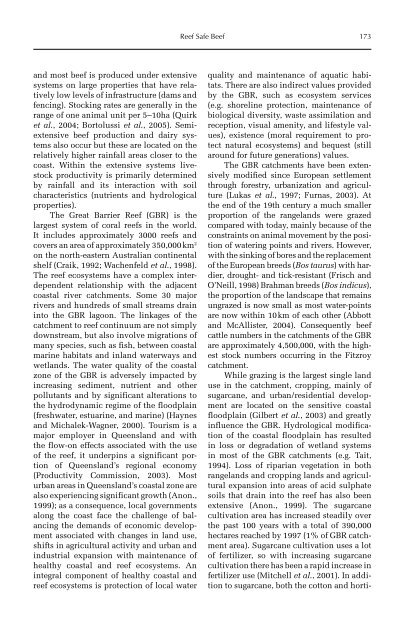Redesigning Animal Agriculture
Redesigning Animal Agriculture
Redesigning Animal Agriculture
You also want an ePaper? Increase the reach of your titles
YUMPU automatically turns print PDFs into web optimized ePapers that Google loves.
and most beef is produced under extensive<br />
systems on large properties that have relatively<br />
low levels of infrastructure (dams and<br />
fencing). Stocking rates are generally in the<br />
range of one animal unit per 5–10ha (Quirk<br />
et al., 2004; Bortolussi et al., 2005). Semiextensive<br />
beef production and dairy systems<br />
also occur but these are located on the<br />
relatively higher rainfall areas closer to the<br />
coast. Within the extensive systems livestock<br />
productivity is primarily determined<br />
by rainfall and its interaction with soil<br />
characteristics (nutrients and hydrological<br />
properties).<br />
The Great Barrier Reef (GBR) is the<br />
largest system of coral reefs in the world.<br />
It includes approximately 3000 reefs and<br />
covers an area of approximately 350,000 km 2<br />
on the north-eastern Australian continental<br />
shelf (Craik, 1992; Wachenfeld et al., 1998).<br />
The reef ecosystems have a complex interdependent<br />
relationship with the adjacent<br />
coastal river catchments. Some 30 major<br />
rivers and hundreds of small streams drain<br />
into the GBR lagoon. The linkages of the<br />
catchment to reef continuum are not simply<br />
downstream, but also involve migrations of<br />
many species, such as fish, between coastal<br />
marine habitats and inland waterways and<br />
wetlands. The water quality of the coastal<br />
zone of the GBR is adversely impacted by<br />
increasing sediment, nutrient and other<br />
pollutants and by significant alterations to<br />
the hydrodynamic regime of the floodplain<br />
(freshwater, estuarine, and marine) (Haynes<br />
and Michalek-Wagner, 2000). Tourism is a<br />
major employer in Queensland and with<br />
the flow-on effects associated with the use<br />
of the reef, it underpins a significant portion<br />
of Queensland’s regional economy<br />
(Productivity Commission, 2003). Most<br />
urban areas in Queensland’s coastal zone are<br />
also experiencing significant growth (Anon.,<br />
1999); as a consequence, local governments<br />
along the coast face the challenge of balancing<br />
the demands of economic development<br />
associated with changes in land use,<br />
shifts in agricultural activity and urban and<br />
industrial expansion with maintenance of<br />
healthy coastal and reef ecosystems. An<br />
integral component of healthy coastal and<br />
reef ecosystems is protection of local water<br />
Reef Safe Beef 173<br />
quality and maintenance of aquatic habitats.<br />
There are also indirect values provided<br />
by the GBR, such as ecosystem services<br />
(e.g. shoreline protection, maintenance of<br />
biological diversity, waste assimilation and<br />
reception, visual amenity, and lifestyle values),<br />
existence (moral requirement to protect<br />
natural ecosystems) and bequest (still<br />
around for future generations) values.<br />
The GBR catchments have been extensively<br />
modified since European settlement<br />
through forestry, urbanization and agriculture<br />
(Lukas et al., 1997; Furnas, 2003). At<br />
the end of the 19th century a much smaller<br />
proportion of the rangelands were grazed<br />
compared with today, mainly because of the<br />
constraints on animal movement by the position<br />
of watering points and rivers. However,<br />
with the sinking of bores and the replacement<br />
of the European breeds (Bos taurus) with hardier,<br />
drought- and tick-resistant (Frisch and<br />
O’Neill, 1998) Brahman breeds (Bos indicus),<br />
the proportion of the landscape that remains<br />
ungrazed is now small as most water-points<br />
are now within 10 km of each other (Abbott<br />
and McAllister, 2004). Consequently beef<br />
cattle numbers in the catchments of the GBR<br />
are approximately 4,500,000, with the highest<br />
stock numbers occurring in the Fitzroy<br />
catchment.<br />
While grazing is the largest single land<br />
use in the catchment, cropping, mainly of<br />
sugarcane, and urban/residential development<br />
are located on the sensitive coastal<br />
floodplain (Gilbert et al., 2003) and greatly<br />
influence the GBR. Hydrological modification<br />
of the coastal floodplain has resulted<br />
in loss or degradation of wetland systems<br />
in most of the GBR catchments (e.g. Tait,<br />
1994). Loss of riparian vegetation in both<br />
rangelands and cropping lands and agricultural<br />
expansion into areas of acid sulphate<br />
soils that drain into the reef has also been<br />
extensive (Anon., 1999). The sugarcane<br />
cultivation area has increased steadily over<br />
the past 100 years with a total of 390,000<br />
hectares reached by 1997 (1% of GBR catchment<br />
area). Sugarcane cultivation uses a lot<br />
of fertilizer, so with increasing sugarcane<br />
cultivation there has been a rapid increase in<br />
fertilizer use (Mitchell et al., 2001). In addition<br />
to sugarcane, both the cotton and horti-










